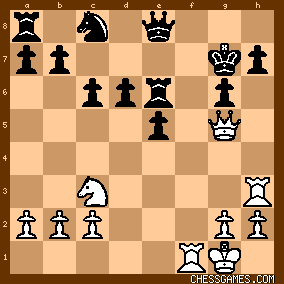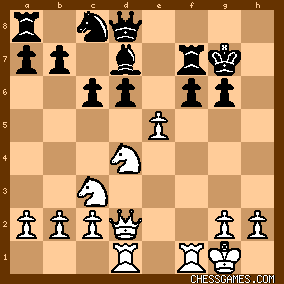| Nov-09-04 | | Whitehat1963: Interesting game that features the opening of the day. |
|
Nov-09-04
 | | Sneaky: Vintage Blackburne. I really admire how forcefully he transitions from the opening to a sharp attacking middlegame. However I don't understand 9.Bf3. It seems l ike Blackburne could have done everything he did and omit this move. What's the point? |
|
| Nov-10-04 | | Saruman: <Sneaky> Personally I would have preferred 9.f4 with a strong center. 9.Bf3 is a matter of taste and white still threatens e5, the difference being that d5 is occupied twice. Although Steinitz would play -d6 anyway. |
|
| Apr-28-06 | | SJP: <saruman> 9...d5 gives 10. e5 Ne8 11. Bg5! which is awkward for Black. 19. e5!! is a beautiful, beautiful move. |
|
| Dec-17-06 | | shr0pshire: Reshevsky designates this as one of chess' greatest upsets in his book. 8. ... Ne7 Reshevsky questions. He wonders why black just doesn't play Re8 instead. 18. ...Nc8 Reshevsky calls this the losing move. He says the saving move was 18. ...Qb6 |
|
| Jan-14-07 | | Rubenus: <Saruman> I agree with you, I would prefer 9. f4 |
|
| Feb-11-07 | | ksadler: An incredible finish by Blackburne! Great game! |
|
Aug-07-08
 | | Pawn and Two: In a favorable position, Blackburne played the puzzling move 19.e5?!. In the tournament book, Steinitz said the plan which 19.e5 initiated was ingenious, in that it was puzzling in actual play, but not analytically as sound as 19.Nce2 threatening 20.Nf4. Blackburne remarked that Steinitz described 19.e5 as, <"a puzzling plan of attack">. Blackburne then gave us a snapshot of the scene when 19.e5 was played: <"It took both him and the spectators by surprise."> A review by Fritz indicates Steinitz's evaluation was very accurate. Fritz indicated White's best continuation was: (1.46) (20 ply) 19.Nce2! Kg8 20.Nf4 Ne7, and now 21.Nfe6! or 21.Nde6!, is strongly in favor of White. Regarding 19.e5, Fritz indicated: (.08) (20 ply) 19.e5 fxe5 20.Ne6+ Bxe6 21.fxe6 Re7. At this point, White could try: (.40) (24 ply) 22.Ne4 Rxe6 23.Rf3 d5 24.Rdf1, or (.27) (24 ply) 22.Qg5 Nb6 23.Qf6+ Kg8 24.Rf2, with a small advantage for White in both variations. |
|
Aug-07-08
 | | Pawn and Two: <shr0pshire: 18...Nc8 Reshevsky calls this the losing move. He says the saving move was 18...Qb6.> Steinitz was correct in rejecting 18...Qb6?. This move would have given Black a clearly losing position after: (2.46) (21 ply) 19.Na4 Qc7 20.Ne6+ Bxe6 21.fxe6 Rff8 22.Qxd6 Qxd6 23.Rxd6. |
|
| Aug-08-08 | | chess man: White was consistent in development, opened up the game with the e-pawn and f-pawns, and it paid off. |
|
Aug-08-08
 | | Pawn and Two: As indicated by Steinitz and Fritz, White would have had better winning chances by playing 19.Nce2!. After 19.e5?!, Black had definite chances of saving the game. After 19.e5?! fxe5 20.Ne6+ Bxe6 21.fxe6 Re7, Fritz indicates White has a small advantage after (.40) (24 ply) 22.Ne4 Rxe6 23.Rf3 d5 24.Rdf1. However, White played 22.Qg5, and this could have led to an approximately equal position after: (.27) (24 ply) 22.Qg5 Nb6! 23.Qf6+ Kg8 24.Rf2, (.07) (24 ply) 24...Rg7 25.Ne4 Nd5 26.Qf3 Qe7 27.c4 Nf4 28.Rxd6. Instead of replying 22...Nb6!, Steinitz made a fatal error by playing 22...Qe8??. In the tournament book, Steinitz stated, < A fearful blunder, 22...Nb6 would not alone have saved the game, but in all probability have been sufficient to win.>. Steinitz is correct that 22...Nb6 was Black's best move, but the result would have been an approximately equal position after 23.Qf6+. A variation indicated by Steinitz, 22...Nb6 23.Rd3, is inferior for White. After the game was completed, Steinitz and Blackburne played over the position, apparently trying moves other than 22...Qe8??. It appears Steinitz had a hard time trying to hold the position, for Blackburne commented: <Steinitz says this was a grave error, but on trying the game over afterwards we found that he could scarcely hope to obtain an equal position.> |
|
| Jun-15-09 | | David2009: 24...Qe7? led to mate in three.

click for larger view
How does White win after 24 ...Re7 instead? |
|
| Oct-18-10 | | sevenseaman: That R sacrifice on f8 in order to obtain total sway on the h file should mean the world to any chess aficionado. The mate that follows is, as in detective parlance, an 'open and shut' case . I would have loads of hesitation in going in with 19. e5 but it is the critical move that starts the landslide, a very gutsy one too. Its a masterclass by Blackburne against the very top in the game. Hats off. |
|
| Mar-29-11 | | pink gorilla: What about 22 Qb6+ for steinitz? |
|
| Mar-29-11 | | bvwp: The thing about 18...Nc8 is that Steinitz was always confident he had time for manoeuvres. Usually he was right. Sometimes a sharp player like Blackburn could catch him on the hop. |
|
| Mar-29-11 | | izimbra: <bvwp> My cost of automation would be one of these - http://www.amazon.com/NP-02-Switcha... - and a few hours of programming. How is it for "Carlsen"? |
|
Mar-29-11
 | | Pawn and Two: <pink gorilla: What about 22...Qb6+ for Steinitz?> It appears Black does not have the time to play his Queen to b6. After 22...Qb6+? 23.Kh1, how does he defend his position? If 23...Qc7 24.Qf6+ Kh6 25.Rd3!, or 23...Qd8 24.Rf7+! Rxf7 25.Qxd8, or 23....Kg8 24.Ne4! Rxe6 25.Nf6+ Rxf6 26.Qxf6 Ne7 27.Rxd6, are all clear wins for White. Black's best defense after 22...Qb6+? 23.Kh1, is 23...Rxe6. However, here too White has a winning advantage: (2.17) (23 ply) 24.Qg4 Re8 25.Ne4 Qc7 26.Qh4 Qe7 27.Nf6 Kh8 28.Nxe8 Qxe8, (3.21) (23 ply) 29.Rf6 Qe7 30.Rdf1 Nb6 31.Rf7+. Steinitz was correct in recommending 22...Nb6! (see my posting on 08/08/08), however, he was incorrect in indicating this move would give Black the advantage. After 22...Nb6!, the position would have been approximately equal. White would be winning after 22...Qb6+?, and after 22...Qe8? <A fearful blunder - Steinitz>, Black's game was hopeless. |
|
| Dec-28-18 | | DonChalce: i call this Blackburne's Mute Mate, because it came so fluid and natural :3 |
|
Dec-12-20
 | | fredthebear: I would regard this beauty as a Kill Box Mate Deflection Sacrifice for a Corridor Mate/Support Mate. Here are 36 checkmate patterns to know:
https://chessfox.com/checkmate-patt... |
|
Dec-20-20
 | | nizmo11: Blackburne should have played first 19.fxg6! hxg6 and now 20.e5!!

click for larger view
Afer this, there is no defense. One variation 20...fxe5 (what else?) 21. Rxf7+ Kxf7 22. Qh6! exd4 23. Qh7+ Kf6 24. Qh4+ |
|
| Jul-17-22 | | Luong Thi Hoa Mai: I have the book of the London Tournament of 1883 in first edition and I say this to clarify that there in the book it is mentioned that Steinitz resigned after move 26 Tf8. That is to say that Steinitz didn't play until mate one move later. Is that a mistake? I think so, if someone can clarify that detail please. |
|





































